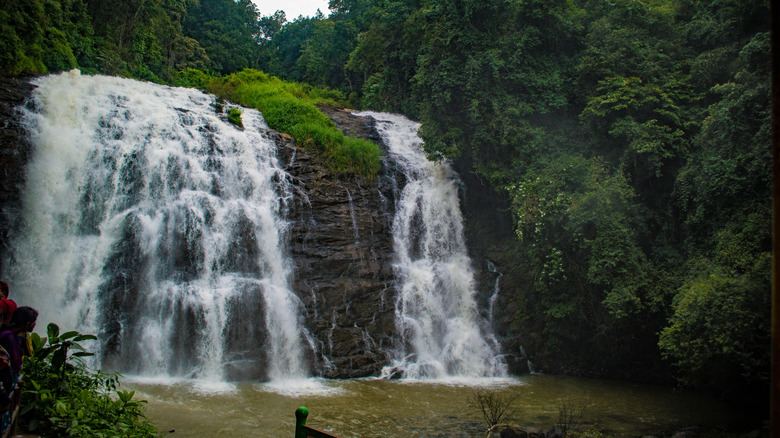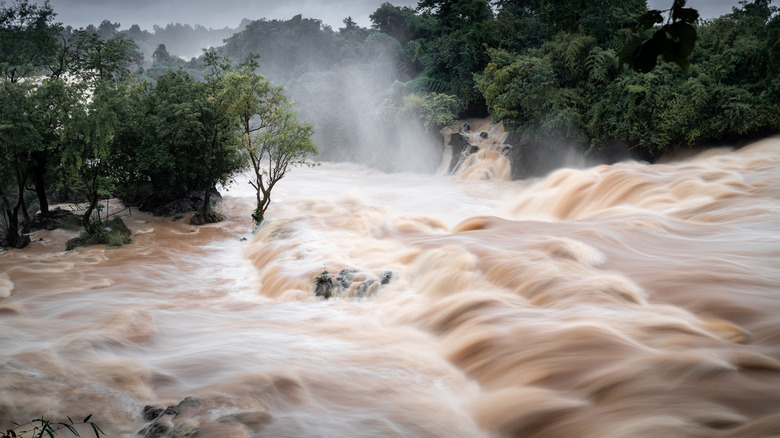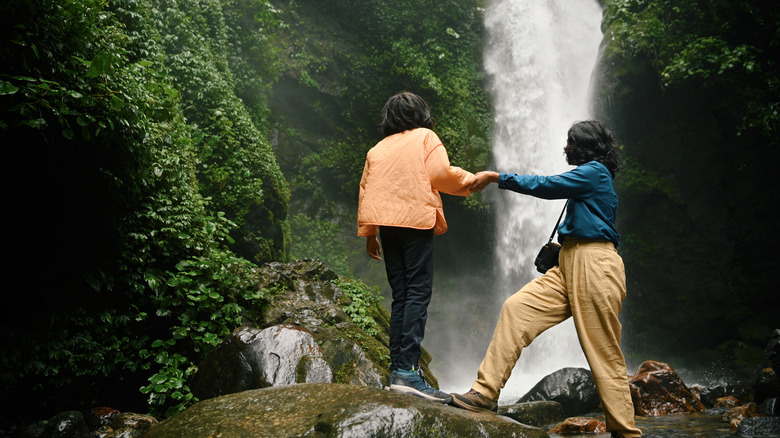The Best Way To Keep Your Family Safe While Visiting Waterfalls During Monsoon Season
Don't listen to TLC — chase all the waterfalls you want. Because whether you're hitting up some of the most beautiful waterfalls in the world or simply exploring local cascades in your area, there's just something special about cooling off surrounded by nature as water falls over your head. However, in between the breathtaking views and refreshing experience, it's also worth noting that going waterfall hunting isn't necessarily without risk. Even more so considering that these idyllic destinations can quickly become hazardous if you're not cautious — especially during monsoon season, when rainfall increases.
And while some travelers might be looking forward to exploring the lush landscapes and thundering rivers and waterfalls that typically come with more rain, there's also no denying that monsoon season has its risks. After all, it typically means one major thing: unpredictability. Whether it's sudden downpours, flash floods, or rapidly changing water levels, these conditions can transform even the most serene waterfall into a dangerous place to be in a matter of minutes.
That said, it's always important to stay vigilant and prepared when visiting a waterfall during monsoon season (or any time of year). This includes things like checking weather forecasts to recognize warning signs, wearing the right gear, and keeping a safe distance from the water's edge — all of which can ultimately ensure that you and your family's waterfall excursion is both enjoyable and safe.
How waterfalls change during monsoon season
Put simply, monsoons happen when there's a significant change in wind patterns and rainfall — resulting in either a very wet or very dry season. Typically associated with tropical and subtropical destinations — think Southeast Asia, India, and Australia, just to name a few — monsoons generally happen between April and September. Humid and rainy, these months are often referred to as the "summer monsoon" season, when crops thrive and landscapes flourish. Nonetheless, harsh monsoon rains can also wreak havoc on local communities — and become incredibly dangerous for anyone who isn't prepared.
Specifically, in the case of waterfalls, monsoon season brings dramatic changes. First, there's the increased water volume, which means a heavier water flow that can transform a gentle cascade into a thundering beast. And while this might look cool in theory, it also increases the risk of accidents and dangerous conditions that can quickly overwhelm even the strongest of swimmers.
Then, there's also the issue with increased erosion, where the extra pressure damages the waterfall's structure much faster than normal. Throw in the unstable terrains and flash floods that also come with heavier rains, and you're dealing with a pretty hazardous environment where one misstep can mean serious injury ... or worse.
What to keep in mind when visiting a waterfall
Luckily, there are a few extra measures you can take so that monsoon season doesn't put a major stop to any of your travel and exploration plans. For starters, the easiest and best thing you can do to ensure your family's safety is to keep a close watch on the weather forecast. If you notice there's a chance of heavy rains or storms for a specific day, plan around that — hit up a local museum instead, for example — and stay away from waterfalls and other bodies of water until the conditions have improved.
In addition to this, you'll also want to pack smart and be well prepared before heading out on your big adventure. Make sure you're wearing the right footwear — closed-toe and non-slip shoes are a must — and stick to lightweight clothing. Other essentials while visiting waterfalls during monsoon season include waterproofing your backpack for added safety, bringing a set of extra clothes, and even carrying a DIY first-aid or "survival" kit you can use in an emergency situation.
Lastly, it's recommended that you only walk along marked paths — that means don't go off-roading or explore uncharted areas, unless you're with an experienced local guide who can quickly get you back to safety. And always keep a safe distance from the edge of the waterfall to minimize the possibility of getting swept away by the heavy currents. By doing so, you can significantly reduce any potential risks — and soak up the best of "waterfall season" wherever you go.


